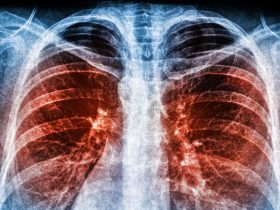The Centers for Disease Control and Prevention (CDC) estimates that between 2010 and 2020, influenza resulted in 9 million to 45 million illnesses, 140,000 to 810,000 hospitalizations, and 12,000 to 61,000 deaths.1
Adding significant weight to these already heavy stats, a cross-section study from CDC researchers, published in the October 2020 issue of Annals of Internal Medicine, looked specifically at 89,999 US adults hospitalized with the flu over eight flu seasons (2010-11 through 2017-18). The study found that nearly 12% of patients hospitalized with the flu – one out of every eight patients – suffered an acute cardiovascular event. The most common events were acute heart failure (6.2%) and acute ischemic heart disease (5.7%). Among these patients, 31.2% were admitted to an intensive care unit, 14.0% required mechanical ventilatory support, and 7.3% died in the hospital. 2, 3
Previous studies support these findings. For example, a 2018 study found that the risk of heart attack was six times higher within a week of confirmed flu infection.4 Although, the CDC’s report brings new information to the table. “Previous to our study, there had been suggestions between the link, but our study shows just how common it is,” said lead author Eric Chow, an infectious diseases fellow at University of Washington School of Medicine.
A Heart-to-Heart About Lowering Flu Risk
According to CDC researchers, the fact that nearly 12% of adult patients hospitalized with the flu have an acute cardiovascular (CV) event underscores the need to strengthen patient knowledge on steps to help reduce risk of catching the flu.
Now may be an excellent moment in history to ramp up that conversation – since everyone from Dr. Anthony S. Fauci, MD, director of the National Institute of Allergy and Infectious Diseases, to Dr. Mom is intensely focused on precautionary steps to avoid viral infection.
1. Persons at a higher risk for COVID-19 have gained early eligibility for a COVID-19 vaccine – and many of these folks are thrilled with their status. In a perfect world, these same people, who are also at high risk for influenza complications such as CV, will keep the vaccine mojo going and be more onboard for an annual flu shot.
Here’s an extra nudge for people with heart disease or risk of heart disease to schedule that annual flu shot. In October 2020, the American Heart Association, the American Diabetes Association, and the American Lung Association issued a first-time-ever joint statement that urged America’s “117 million adults living with chronic disease to prioritize annual flu vaccination.” The statement further called upon “health care professionals to advocate for and support flu immunization within their practices.”5
Eduardo Sanchez, MD, American Heart Association Chief Medical Officer for Prevention said,
Getting the flu can lead to complications with very serious consequences for people with cardiovascular disease, including hospitalization, increased risk for other major health events like heart attacks or strokes, and death. Flu vaccination is a good idea for all and has actually been associated with lower rates of some cardiac events.”
2. With so many Americans primed to seek immediate attention for COVID-19-related symptoms, it may be an opportune time to encourage equally swift medical care for flu symptoms. Why? Because early antiviral medication for influenza is key to lowering risk of serious flu complications, such as cardiovascular events, but time is of the essence.
Antiviral treatment is most effective when prescribed by a healthcare provider within 48 hours after flu symptoms begin. When initiated within this 2-day period, antiviral treatment typically lessens fever and flu symptoms and shortens the time someone is ill by about one day.6
In addition, the CDC reports that antiviral treatment may reduce the risk of complications associated with asthma, respiratory issues, diabetes, heart disease, and additional health issues that could require hospitalization.6
3. With the start of 2021 – and one year after COVID-19 was identified – most Americans had memorized those DIY measures to lessen risk of infection. Healthcare providers might want to take advantage of this situation and in fact reinforce their patients’ connection to these steps – since the 3-pronged strategy works equally well to reduce risk of flu. The trifecta of viral infection protection is:
- Wash hands often.
- Wear a face mask.
- Watch your distance, maintaining 6 feet between you and another.
It’s what the CDC calls the “Three W’s”,7 and while this plan of action helps reduce everyone’s risk for any viral infection, it’s a particularly important strategy to help mitigate infection and potentially attenuating influenza-related cardiovascular complications and adverse outcomes.
Weakening the link between influenza and possible heart complications comes down to intelligent steps that help avoid getting the flu or lessening flu severity. Fortunately, the strategy mirrors what most Americans are already doing to reduce risk of testing positive for COVID-19. The overlap may make this the best time ever to reinforce health advice that Americans are already focused on.
1. The Centers for Disease Control and Prevention; Disease Burden of Influenza; https://www.cdc.gov/flu/about/burden/index.html#:~:text=While%20the%20impact%20of%20flu,61%2C000%20deaths%20annually%20since%202010. 2. The Centers for Disease Control and Prevention; CDC Study Finds Sudden, Serious Cardiac Events Common in Adults Hospitalized with Flu; retrieved at https://www.cdc.gov/flu/spotlights/2019-2020/cardiac-events-flu.htm#:~:text=August%2025%2C%202020%20%E2%80%93%20A%20CDC,(~12%25%20of%20patients). 3. Eric J. Chow, Melissa A. Rolfes, Alissa O’Halloran, et al. Acute Cardiovascular Events Associated With Influenza in Hospitalized Adults: A Cross-sectional Study. Ann Intern Med.2020;173:605-613. [Epub ahead of print 25 August 2020]; retrieved at https://www.acpjournals.org/doi/10.7326/M20-1509 4. J.C. Kwong, K.L. Schwartz, M.A. Campitelli, H. Chung, N.S. Crowcroft, T. Karnauchow, K. Katz, D.T. Ko, A.J. McGeer, D. McNally, D.C. Richardson, L.C. Rosella, A. Simor, M. Smieja, G. Zahariadis, J.B. Gubbay Acute Myocardial Infarction after Laboratory-Confirmed Influenza Infection N Engl J Med, 378 (2018), pp. 345 353, https://www.nejm.org/doi/10.1056/NEJMoa17020900 5. American Heart Association; Nation’s Top Health Organizations Band Together to Urge Patients to Get Flu Vaccinations to Prevent Serious Health Risks; retrieved at https://newsroom.heart.org/news/nations-top-health-organizations-band-together-to-urge-patients-to-get-flu-vaccinations-to-prevent-serious-health-risks 6. Centers for Disease Protection and Control; What You Should Know About Flu Antiviral Drugs; retrieved at https://www.cdc.gov/flu/treatment/whatyoushould.htm 7. Centers for Disease Protection and Control; 3 W’s to reduce the risk of COVID-19 https://preventepidemics.org/covid19/science/insights/3-ws-to-reduce-the-risk-of-covid-19/







